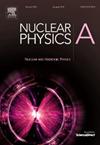An improved unified fission model for α-decay half-lives
IF 1.7
4区 物理与天体物理
Q2 PHYSICS, NUCLEAR
引用次数: 0
Abstract
An improved unified fission model (IMUFM) is developed for α-decay half-lives by introducing an analytical expression of the equivalent assault frequency and using a modified version of Woods-Sanox potential. The parameters of the analytical expression are determined by fitting the experimental α-decay half-lives from the ground state to ground state transitions. By comparing the agreement between the calculated ones and the experimental half-lives, it is found that the accuracy of IMUFM is improved significantly than its predecessor. Then the IMUFM is extended to study the α-decay properties of the superheavy nuclei with Z=118-120 isotopes. The α-decay half-lives of these nuclei are predicted within the IMUFM by inputting the values that extracted from the Weizsäcker-Skyrme-4 (WS4) model, the finite-range droplet model (FRDM) and the Koura-Tachibaba-Uno-Yamada (KTUY) formula, respectively. By observing the evolution of the values and the half-lives of Z=118-120 isotopes versus the neutron number N, the shell effects at N=178 and N=184 are shown evidently. At last, the dominant decay modes of , and α-decay chains are investigated by studying the competition between α-decay and spontaneous fission (SF), which might be helpful for identifying these nuclides in future experiments.
α衰变半衰期的改进统一裂变模型
引入等效攻击频率的解析表达式,采用改进的Woods-Sanox势,建立了α衰变半衰期的改进统一裂变模型。通过拟合实验α-衰变从基态到基态过渡的半衰期来确定解析表达式的参数。通过比较计算值与实验半衰期的一致性,发现IMUFM的精度比前一种方法有了明显的提高。然后将IMUFM扩展到研究Z=118 ~ 120同位素的超重核α-衰变性质。通过输入从Weizsäcker-Skyrme-4 (WS4)模型、有限范围液滴模型(FRDM)和Koura-Tachibaba-Uno-Yamada (KTUY)公式中分别提取的Qα值,在IMUFM内预测了这些原子核的α衰变半衰期。通过观察Z=118 ~ 120同位素的Qα值和半衰期随中子数N的变化,可以明显地看出N=178和N=184处的壳层效应。最后,通过α-衰变与自发裂变(SF)之间的竞争,探讨了118296、119297和120298 α-衰变链的优势衰变模式,为今后实验中识别这些核素提供了依据。
本文章由计算机程序翻译,如有差异,请以英文原文为准。
求助全文
约1分钟内获得全文
求助全文
来源期刊

Nuclear Physics A
物理-物理:核物理
CiteScore
3.60
自引率
7.10%
发文量
113
审稿时长
61 days
期刊介绍:
Nuclear Physics A focuses on the domain of nuclear and hadronic physics and includes the following subsections: Nuclear Structure and Dynamics; Intermediate and High Energy Heavy Ion Physics; Hadronic Physics; Electromagnetic and Weak Interactions; Nuclear Astrophysics. The emphasis is on original research papers. A number of carefully selected and reviewed conference proceedings are published as an integral part of the journal.
 求助内容:
求助内容: 应助结果提醒方式:
应助结果提醒方式:


